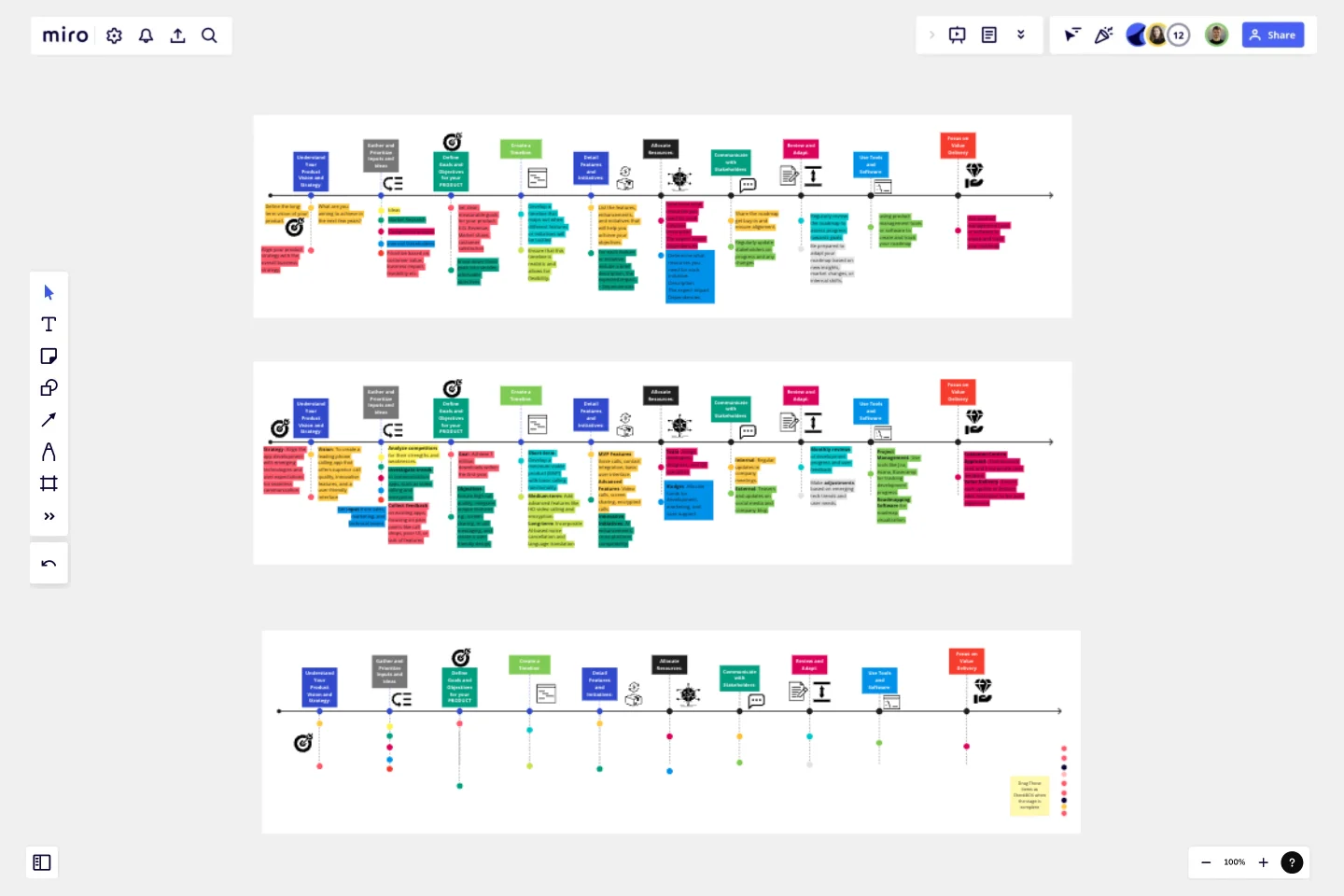Product Roadmap by Mark V. Smetanin
Blueprint to Success: Mastering Product Roadmap.
This framework guides product managers through the systematic process of creating an effective and adaptable product roadmap, ensuring alignment with business goals and market dynamics.
Creating a product roadmap as a product manager involves several key steps. Here's a general guide to help you through the process:
Understand Your Product Vision and Strategy:
Define the long-term vision of your product. What are you aiming to achieve in the next few years?
Align your product strategy with the overall business strategy. Understand how your product contributes to the broader goals of the company.
Gather and Prioritize Inputs:
Collect insights from various sources like market research, customer feedback, competitive analysis, and internal stakeholders.
Prioritize these inputs based on factors like customer value, business impact, feasibility, and alignment with your product vision.
Define Goals and Objectives:
Set clear, measurable goals for your product. These could be related to revenue, market share, customer satisfaction, etc.
Break down these goals into smaller, achievable objectives.
Create a Timeline:
Develop a timeline that maps out when different features or initiatives will be tackled. This includes short-term, medium-term, and long-term plans.
Ensure that this timeline is realistic and allows for flexibility.
Detail Features and Initiatives:
List the features, enhancements, and initiatives that will help you achieve your objectives.
For each feature or initiative, include a brief description, the expected impact, and any dependencies.
Allocate Resources:
Determine what resources (team members, budget, technology, etc.) are needed for each initiative.
Plan for resource allocation keeping in mind the capacity of your team and budget constraints.
Communicate with Stakeholders:
Share the roadmap with internal stakeholders (teams, executives) to get buy-in and ensure alignment.
Regularly update stakeholders on progress and any changes to the roadmap.
Review and Adapt:
Regularly review the roadmap to assess progress towards goals.
Be prepared to adapt your roadmap based on new insights, market changes, or internal shifts.
Use Tools and Software:
Consider using product management tools or software to create and track your roadmap. Tools like Aha!, ProductPlan, or Roadmunk can be useful.
Focus on Value Delivery:
Always keep the focus on delivering value to customers and the business.
Be open to feedback and iterate on your product based on real-world usage and changing needs.
This template was created by Mark V. Smetanin.
Get started with this template right now.
BCG Matrix Template
Works best for:
Strategic Planning
Use the BCG matrix template to make informed and strategic decisions about growth opportunities for your business. Assign your portfolio of products to different areas within the matrix (cash cows, dogs, question marks, stars) to prioritize where you should invest your time and money to see the best results.
Roadmap Planning Template
Works best for:
Roadmap, Agile
The Roadmap Planning Template in Miro is a dynamic tool designed to streamline the process of planning and tracking project milestones. This template is part of Miro's Intelligent Templates offering, which integrates AI, interactive widgets, and automation to enhance productivity. One key feature of this template is its real-time collaboration capability, allowing team members to work together seamlessly, regardless of their location. This feature ensures that everyone is on the same page, making it easier to assign tasks, set deadlines, and track progress effectively.
Empathy Map by Aremu Dominion
Works best for:
Product Management
Improve your understanding of customer needs with the Empathy Map by Aremu Dominion. This template allows you to capture and analyze your audience's emotions, thoughts, and experiences. Use it to create user-centered products and services that resonate with your customers. Perfect for design thinking workshops, product development, and marketing teams focused on empathy-driven innovation.
Research Topic Brainstorm Template
Works best for:
Desk Research, Brainstorming, Ideation
Coming up with a topic for a research project can be a daunting task. Use the Research Topic Brainstorm template to take a general idea and transform it into something concrete. With the Research Topic Brainstorm template, you can compile a list of general ideas that interest you and then break them into component parts. You can then turn those parts into questions that might be the focus for a research project.
Epic & Feature Roadmap Planning
Epic & Feature Roadmap Planning template facilitates the breakdown of large-scale initiatives into manageable features and tasks. It helps teams prioritize development efforts based on business impact and strategic objectives. By visualizing the relationship between epics and features, teams can effectively plan releases and ensure alignment with overall project goals and timelines.
Project Timeline Builder
Works best for:
Timeline, Planning
The Project Timeline Builder template is a powerful tool for planning and managing project timelines. It helps you break down projects into manageable tasks, set deadlines, and track progress. This template ensures you stay organized and meet your project goals efficiently.
